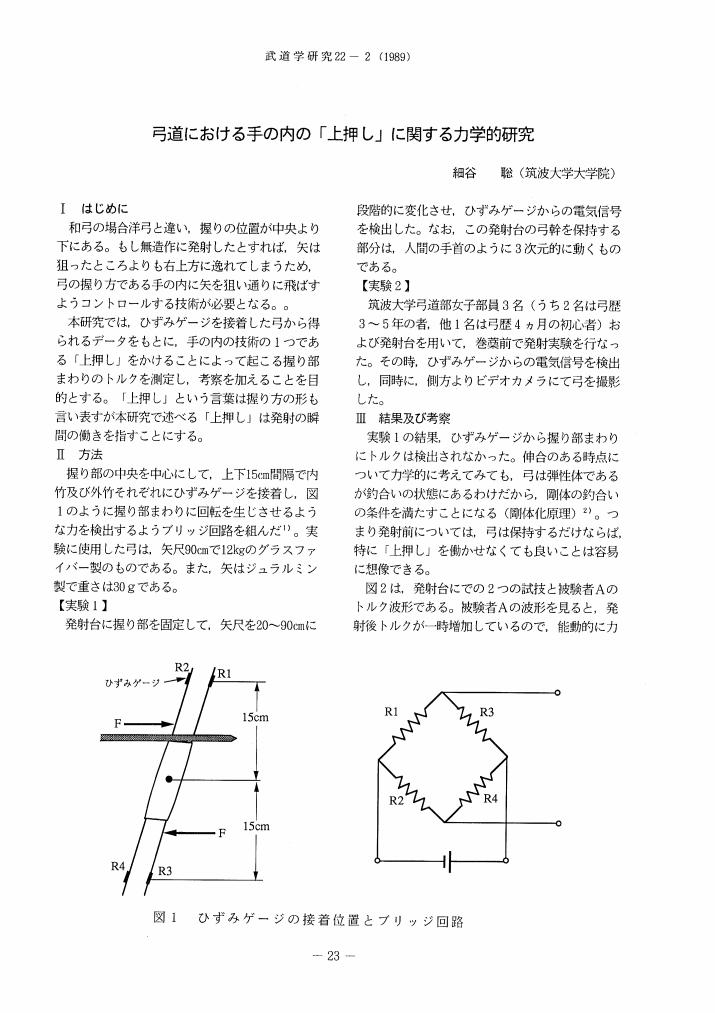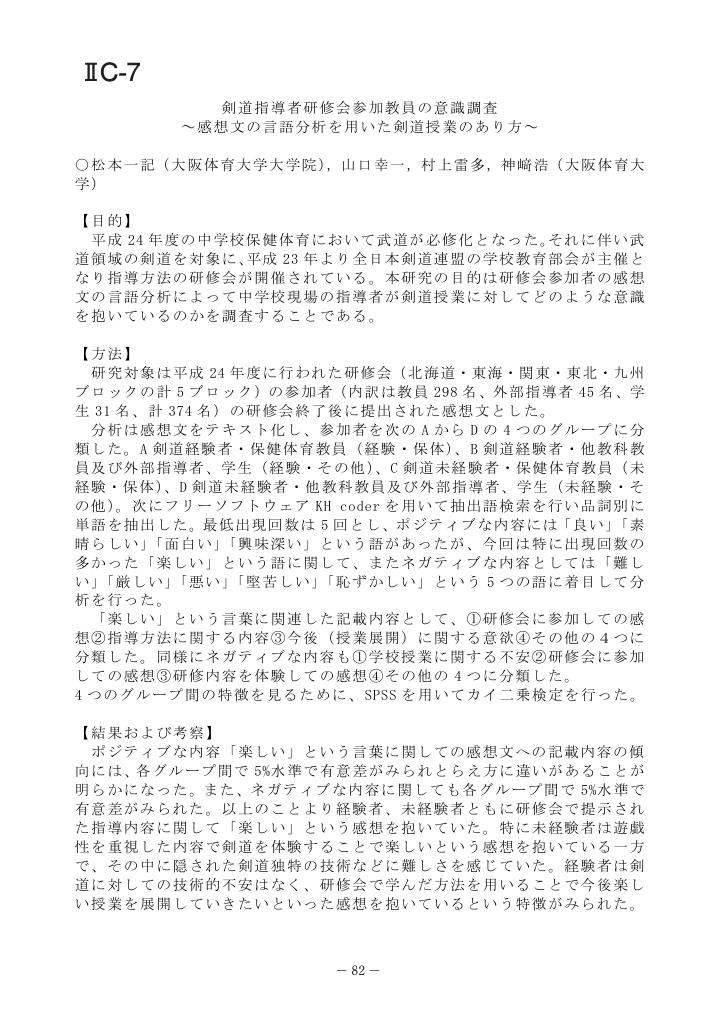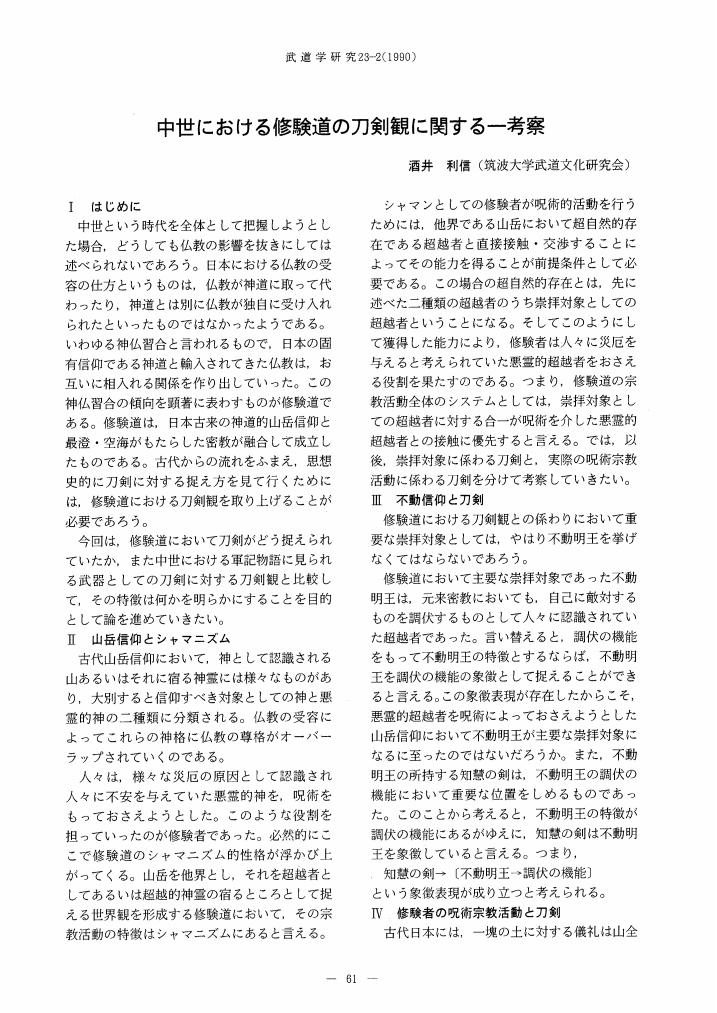1 0 0 0 OA 柔道選手の形態と機能の特徴について
1 0 0 0 東洋の格闘技―中国少林武術について―
- 著者
- 藤堂 良明
- 出版者
- 日本武道学会
- 雑誌
- 武道学研究 (ISSN:02879700)
- 巻号頁・発行日
- vol.27, no.3, pp.38-44, 1995
The main theme of Japanese Academy of Budo was to study the history and technology of Japanese Budo. It would be necessarry for us to research the combat Sports is the Orient after this. Taking part in the 3rd Chinese International Shorin Bujutsu tournament, I consider about the form and substance of Bujutsu tournament and the history of Shorin Bujutsu.<br>1) Shorin Bujutsu was the roots of chinesebujutsu. At 5 centuries, some priests have practiced Shorin Bujutsu at Shorin temple. According to Kikoshinsyo written by Keisekiko, the founder of Snorin Bujutsu was Chokyoin who devised 32 kenpou and bludgeon. Priests practicing kenpou based on kick named Hokuken and people practicing kenpou based on push with hands named Nan Ken. Also there was the arts of fencing, whip, sward and stick in Shorin Bujutsu.<br>2) There are Shorin-ken, Taikyoku-ken, Nan-ken, Sword, Stick and Bludgeon in Kata contest of Bujutsu tournament. Each player does not make a bow each other because of practicing it as Bujutsu rather than as Budo. As a match called Sanda, they combat each other with push, kick and throwing. A contestant matches 10 classes of weightism and puts on protecter. The technique of winning is to be seen by throwing rather than pushing and kicking.
1 0 0 0 OA 武道の性格と念と呪
- 著者
- 黒木 俊弘
- 出版者
- 日本武道学会
- 雑誌
- 武道学研究 (ISSN:02879700)
- 巻号頁・発行日
- vol.12, no.1, pp.66-67, 1980-01-30 (Released:2012-11-27)
1 0 0 0 OA 大大名 細川忠利の武芸
- 著者
- 黒木 俊弘
- 出版者
- 日本武道学会
- 雑誌
- 武道学研究 (ISSN:02879700)
- 巻号頁・発行日
- vol.13, no.2, pp.42-43, 1981-03-10 (Released:2012-11-27)
1 0 0 0 剣道選手のピークパフォーマンス時の心理的要因に関する研究
- 著者
- 有田 祐二 武藤 健一郎 土屋 裕睦 鍋山 隆弘 香田 郡秀 佐藤 成明
- 出版者
- 日本武道学会
- 雑誌
- 武道学研究 (ISSN:02879700)
- 巻号頁・発行日
- vol.31, no.1, pp.22-29, 1998
The purpose of this study was to examine the psychological state of the top kendo players when they are playing at their peak. The following results were obtained by using the Garfield Clustering Method on leading players and kendo students.<br>1) The psychological state of both leading kendo players and kendo students when they are performing at their peak can be described as "mentally relaxed, " "focused on the present, " and "highly energized".<br>2) The group of leading kendo players felt that they were "highly in control, " but did not report being in a state that could be described as "Confident, " "transcendation of self (unlikelihood)".
1 0 0 0 OA 剣道練習者の心機能の特徴について
1 0 0 0 「薙刀体操」について
- 著者
- 瑞慶山 良作 井上 アヤ子
- 出版者
- 日本武道学会
- 雑誌
- 武道学研究 (ISSN:02879700)
- 巻号頁・発行日
- vol.37, pp.65-65, 2004
1 0 0 0 OA 弓道における手の内の「上押し」に関する力学的研究
- 著者
- 細谷 聡
- 出版者
- 日本武道学会
- 雑誌
- 武道学研究 (ISSN:02879700)
- 巻号頁・発行日
- vol.22, no.2, pp.23-24, 1989-11-30 (Released:2012-11-27)
- 参考文献数
- 3
1 0 0 0 OA 剣道指導者研修会参加教員の意識調査~感想文の言語分析を用いた剣道授業のあり方~
1 0 0 0 OA 刀剣観における神話的イメージの位置づけに関する一考察
- 著者
- 酒井 利信
- 出版者
- 日本武道学会
- 雑誌
- 武道学研究 (ISSN:02879700)
- 巻号頁・発行日
- vol.27, no.3, pp.12-22, 1995-03-31 (Released:2012-11-27)
- 参考文献数
- 31
- 被引用文献数
- 1
This article aims at analyzing the view of swords in the traditional books of Kenjutsu in the Edo period. The view of swords in the traditional books of Kenjutsu reffers chiefly to myth. From the mythological image may begathered. The purpose of this paper, based on the standpoint of structuralism, is to clarify the constitutive position of the mythological image in the view of swords as a whole in the traditional books of Kenjutsu.Several new findings might be summarized as follows:1. A (system), connected with the Three Sacred Regalia, has carried weight with the view of swords of Kenj utsu.2. The former-mentioned (system) has risen above its own level (i. e. latent consciousness level·common understanding level·real activities level) and forged newly transcendental (sysem).3. This mechanism can be explained that the (structure) of the forme (system), connected with the Three Sacred. Regalia, is a mold of the latter (system).4. The mythological image tied two (systems) together.5. Being accompanied by a major assumption of the formation of a new (system), the mythological image had (inductive property).
1 0 0 0 OA 柔道・剣道選手の体型と姿勢の特徴ならびにその関連性について
- 著者
- 坂東 隆男 浅見 高明 川村 禎三
- 出版者
- 日本武道学会
- 雑誌
- 武道学研究 (ISSN:02879700)
- 巻号頁・発行日
- vol.16, no.2, pp.27-36, 1984-02-29 (Released:2012-11-27)
- 参考文献数
- 34
The purpose of this study was to clarify the characteristics and relationship between somatotype and standing posture in Judoists and Kendoists. In this study the 245 male athletes from 15 sports events at the University of Tsukuba were classified as to their body type by the Heath Carter somatotype method. And measurement was taken of the spine curvatures, the difference of bi-acromion height, the weight distribution between right and left foot and the location of center of gravity in anterior posterior axis of foot.The results were as follows:1. The characteristics in somatotype of Judoists showed large mesomorphic and endomorphic components. The somatotype of Kendoists showed resemblance to that of Soccer and Tennis player.2. The intensified dorsal curvature was one of the characteristics in Judoists' posture. Kendoists had a tendency to be inclined backward in head and neck position.3. Judoists who showed endomorphic mesomorph type had a tendency to be inclined backward in their upper bodies. And Kendoists who showed ectomorphic mesomorph type had a tendency to shift their weight forward.
1 0 0 0 OA 天流に関する一考察
- 著者
- 前村 幸芳
- 出版者
- 日本武道学会
- 雑誌
- 武道学研究 (ISSN:02879700)
- 巻号頁・発行日
- vol.27, no.Supplement, pp.33-33, 1994 (Released:2012-11-27)
1 0 0 0 天流に関する一考察:―仙台藩亘理邑の天流を中心に―
- 著者
- 前村 幸芳
- 出版者
- 日本武道学会
- 雑誌
- 武道学研究 (ISSN:02879700)
- 巻号頁・発行日
- vol.27, pp.33-33, 1994
1 0 0 0 和弓の振動についての力学的研究
- 著者
- 加賀 勝 小林 一敏
- 出版者
- 日本武道学会
- 雑誌
- 武道学研究 (ISSN:02879700)
- 巻号頁・発行日
- vol.18, no.2, pp.49-50, 1985
- 著者
- 稲垣 源四郎 細谷 聡
- 出版者
- 日本武道学会
- 雑誌
- 武道学研究 (ISSN:02879700)
- 巻号頁・発行日
- vol.21, no.2, pp.55-56, 1988
1 0 0 0 OA 自由民権期における警察武術について
- 著者
- 湯浅 晃
- 出版者
- 日本武道学会
- 雑誌
- 武道学研究 (ISSN:02879700)
- 巻号頁・発行日
- vol.33, no.Supplement, pp.5-5, 2000 (Released:2012-11-27)
1 0 0 0 OA 「古式の形」の研究― 甲冑着用の場合
1 0 0 0 OA 中世における修験道の刀剣観に関する一考察
- 著者
- 酒井 利信
- 出版者
- 日本武道学会
- 雑誌
- 武道学研究 (ISSN:02879700)
- 巻号頁・発行日
- vol.23, no.2, pp.61-62, 1990-11-30 (Released:2012-11-27)










